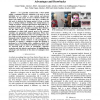Free Online Productivity Tools
i2Speak
i2Symbol
i2OCR
iTex2Img
iWeb2Print
iWeb2Shot
i2Type
iPdf2Split
iPdf2Merge
i2Bopomofo
i2Arabic
i2Style
i2Image
i2PDF
iLatex2Rtf
Sci2ools
ROMAN
2015
IEEE
2015
IEEE
Gaze contingency in turn-taking for human robot interaction: Advantages and drawbacks
— It is generally accepted that a robot should exhibit a contingent behavior, adaptable to the needs of each individual user, to achieve a more natural and pleasant interaction. In this paper we have evaluated whether this general rule applies also when the robot plays a leading role and needs to motivate the human partner to keep a certain pace, as during training or teaching. Also among humans, in schools or factories, structured interaction is often guided by a predefined rhythm, which facilitates the coordination of the partners involved and is thought to maximize their efficiency. On the other hand, a pre-established timing forces all participants to adjust their natural speed to the external, sometimes not appropriate, timing requirement. Where does the optimal trade-off between these two paradigms lie? We have addressed this question in a dictation scenario where the humanoid robot iCub plays the role of a teacher and dictates brief English or Italian sentences to the particip...
Robotics | ROMAN 2015 |
| Added | 17 Apr 2016 |
| Updated | 17 Apr 2016 |
| Type | Journal |
| Year | 2015 |
| Where | ROMAN |
| Authors | Oskar Palinko, Alessandra Sciutti, Lars Schillingmann, Francesco Rea, Yukie Nagai, Giulio Sandini |
Comments (0)

